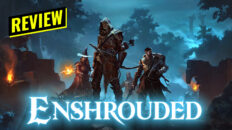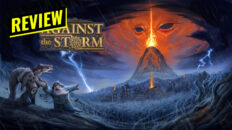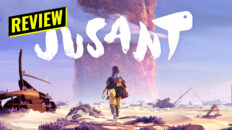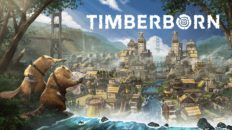Developer: Moon Studios
Publisher: Xbox Game Studios
Reviewed on: PC
Purchased.
Ori and the Will of the Wisps is the follow up to Ori and the Blind Forest, a game I consider to be one of the best contemporary 2D platformers. Will of the Wisps takes the signature presentation and platforming of Blind Forest, and doubles down on just about all of it. It also puts combat front and center adding an arsenal of weapons and even a simple combo system. Ori and the Will of the Wisps is a much bigger more polished game than it’s predecessor that ultimately overshadows Blind Forest in almost every aspect.
The Ori games are 2D Metroid-style platformers, but what sets them apart is the beautifully hand drawn art and fairy-tail storyline. Will of the Wisps picks up a few years after the end of Blind Forest, seeing the trio of Ori, Nora, and Gumo welcoming Ku into their fold. Ku is the orphaned owl child of Kuro, the antagonist of Blind Forest. In the opening moments, Ku and Ori find themselves stranded in a foreign land with a life threatening tragedy befalling Ku. In order to save Ku Ori must cleans the land of darkness by awakening the Wisps who will bring light and life back into the world.

In all fairness, the story retreads a lot of the same territory that Blind Forest did. This is less of a problem if you never played Blind Forest, but it does stand out if you have, especially early on. Luckily Will of the Wisps manages to forge its own path once it gets going. All the characters are well presented and even have unique voice actors. They all speak a fake language, but each one has a personality and quirks. It was always a joy to find Tokk or Lupo in each new area just to see what they have to say. There are also a handful of moments where I felt sadness and remorse as a result of what I had to do in order to save the forest. It’s a testament to not only the characterization, but also the amazing art, animation, and overall presentation of those characters and their place in a world that truly feels alive.
Some of those characters also have major gameplay implications. In order to level up your skills you have to talk to a character, not just open a menu. The same goes for unlocking a new area’s map. There are even full-fledged side quests that run parallel to the main quest. All these things go a long way to make the world feel more alive than it did in Blind Forest. It really feels like this was a place that existed long before your arrival and will continue to thrive after you’ve left.

I mentioned skills before, and boy does Will of the Wisps have a lot of them. Everything falls into one of three categories: abilities, weapons, and shards. Abilities are unlocked through the course of the main story and most of them are required to progress. Several of these return from Blind Forest such as Bash and Dash. There are also a slew of new abilities like a whip that pulls you towards certain objects and enemies. There are easily twice as many abilities as there were in Blind Forest and it can sometimes get overwhelming. While they are primarily focused around traversal, they also have combat uses, in conjunction with the huge arsenal weapons and shards.
The weapons arsenal is where Will of the Wisps really opens up and distinguishes itself from Blind Forest. It’s also where it starts to get top heavy. You start off with a simple, but versatile energy sword. It’s fast and has a nice three-hit combo that works well against weaker and fast moving enemies. It works so well, in fact, that I used it for almost the entire game despite having over half a dozen other weapons to choose from. It’s super easy to swap weapons and abilities at will, even in the heat of combat, but the times I actually did that was small in comparison to how many weapons there actually are. In fact, there are some weapons I never used outside of testing them out. The same can be said for the shards, which you find in secret areas throughout the game.
You start with four shard slots, but can unlock more by completing the game’s combat shrines. The shards cover a huge swath of abilities and perks from double and triple jump, to buffing and debuffing enemies. Much like the weapons, I never found a need to really swap them out once I found the ones I liked. In fact, some of them seem absolutely necessary like double jump and wall clinging, things that are typically permanently unlocked abilities in most platformers. It feels odd to force you to take up a slot that could have been better used for experimenting with other shards. Needless to say, I never removed those from my loadout for the entire game.

Perhaps it’s a testament to how good the weapons, abilities, and shards feel that I never wanted to change my initial loudout. However, by the end I looked at the huge variety of skills I never used and struggled to think of reason for many of them to exist. I’m sure there will be some players that fall in love with a weapon I absolutely hated, so at the end of the day variety is good. It can be a little overwhelming until you realize you can just ignore the stuff you don’t personally like.
This is the part of the review that is hard to put into words. It’s where I say Ori and the Will of the Wisps is one of the best playing games I’ve ever played. It’s not just about the combat and platforming, which is absolutely in a league of its own. It’s more about how those aspect are so effortlessly married with the audio visual presentation. Whether it’s an intense combat encounter where Ori jumps, Bashes, and floats in mid air while attacking and particle effects are firing off and enemies are preparing their next attack. Or a heart-pounding escape sequence where precision platforming is absolutely necessary because a massive monster is chasing you down, all set a bombing orchestral arrangement. Or in the quietest of moments when you chat with a fisherman in a tropical paradise who really just needs a new fishing net.

It’s truly amazing how the game can manage all these different scenarios, while maintaining such a high level of quality throughout. Not once did I notice an awkward animation, a visual glitch, or an improperly placed platform. If I missed a jump it was because I jumped too early or too late. Ori transitions from one weapon or ability to another so seamlessly that it all becomes second nature after a short time. Allowing you to actually watch the dazzling visuals unfold without having to worry about screwing up a button press. The ease in which all the various moves and attacks flow seamlessly from your controller to the screen is nothing short of perfection.
As I said before, Ori and the Will of the Wisps does everything Ori and the Blind Forest did, except bigger and better. As a result, it can feel like a bit of a retread early on. However, once Will of the Wisps breaks free of its opening hours it never stops throwing new and exciting mechanics, levels, abilities, and weapons at you, even if that arsenal may be larger than any one person can truly appreciate. In a lot of ways this feels like the game Moon Studios originally wanted to make and Blind Forest was just a stepping stone. At any rate, Ori and the Will of Wisps is a momentous achievement and a fitting conclusion to Ori’s story.







